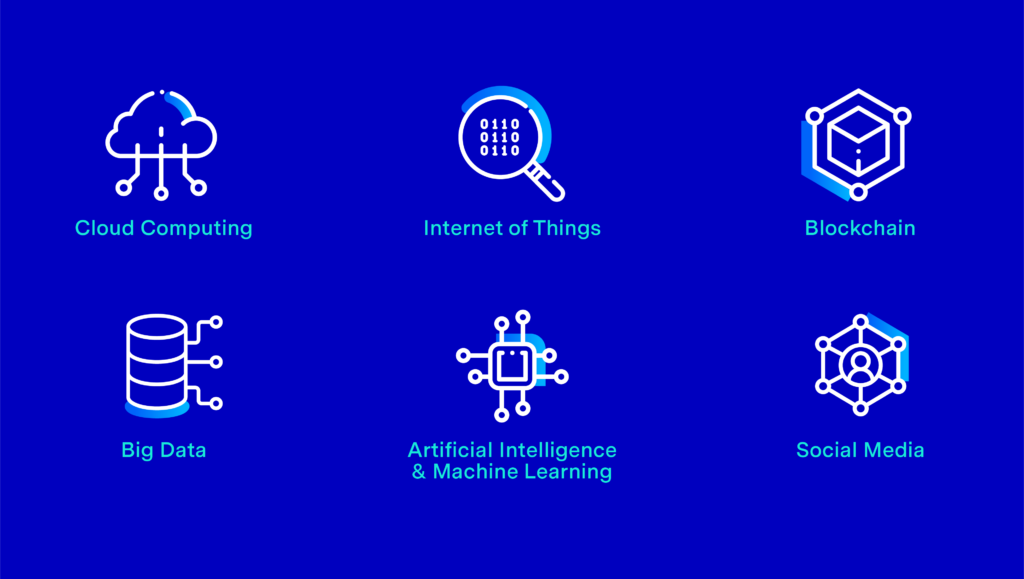Digitalization is challenging many business areas that have been set in stone for decades. Instead of predictable innovation cycles, disruptive changes are occurring that can devalue or even render obsolete currently successful business strategies within a few years. At the same time, digital transformation opens up an abundance of new possibilities that will enable you to successfully navigate your way into the future. In order to exploit these opportunities, it is essential for modern managers to understand the mechanisms behind digital change.
The Essence of Digital Transformation
Computers, networks and software: digital technologies are penetrating all industries, business areas and processes, tearing down old structures and defining new requirements. However, the impact that digitalization is having does not end there. It’s not just turning companies upside down, it’s transforming the business world as a whole and beyond. It is working its magic on pretty much all social processes: the way we work, move, consume and communicate.
Digital transformation describes the comprehensive effects that this change is having on our business world. It challenges companies to reflect on how digital technologies are revolutionizing not only operational business processes, but also business models, value chains and markets. When dealing with this topic, however, it is necessary to be clear about what is characterizing this change.
1. Digital transformation cannot be stopped
The efficiency and penetration of digital innovation have progressed so much that we have crossed a threshold at which there is no turning back. For example, no company can efficiently manage its business processes without an ERP system or reliably handle customer data without IT security. Future challenges such as the regulation of traffic and goods flows will not be solved analogously. Consumers will continue to use mobile devices and demand virtual shopping experiences. The interdependence of digital systems has now reached a level of complexity where there will no longer be any solutions without technology-driven data processing.
2. Digital transformation accelerates all processes
As early as 1965, the co-founder of Intel, Gordon Moore, predicted that the complexity of computers would double every one to two years. Although this development has slowed down somewhat in recent years, Moore’s law points to another characteristic of digital business: it is exponential, rather than linear. The improvements in computing power, memory capacity and transmission speed today enable digital solutions that seemed unthinkable yesterday. In addition, growing levels of digitalization mean that new products and services are establishing themselves in practice more and more quickly.
Half a century ago, the life expectancy of a firm in the Fortune 500 was around 75 years. Now it’s less than 15 years. (Source: Harvard Business Review)
3. Digital transformation is dynamic and cannot be calculated
There were hardly any market observers out there that anticipated the sustained success of tech companies like Google, Apple and Amazon. The accelerated innovation speed of digital transformation makes it increasingly difficult in many industries to assess developments and trends in the medium or long term. In addition, the digital-driven start-up culture is attacking established players with venture capital and exploring new business models and opportunities for value creation across the board. As a result, we are now seeing disruptive upheavals that lead to cross-sector competition and the emergence of powerful megaplayers in newly emerging market segments.
How Information Technology Drives Transformation
IT is the engine of digital transformation. Digital products and services offer modern managers the opportunity to break down established processes at all levels of the company in order to become smarter as an organization. This means, for example, designing products more precisely and with a shorter time-to-market, making operational processes more efficient, winning new customers, opening up new markets and implementing more effective supply chains.
Digital transformation technologies provide valuable tools that help businesses master the digital transformation challenge.
The most important technologies of digital transformation at a glance:
- Cloud Computing: Cloud services provide you with access to applications (software as a service), runtime environments (platform as a service) or hardware resources (infrastructure as a service). You can make your business more flexible by cutting costs and using your own resources more effectively. At the same time, you have access to complex digital solutions without the need for lots of start-up capital.
- Internet of Things: Connectivity and intelligent software enable devices to pass on information. These smart objects can communicate with each other as machines as well as with the outside world. Application areas include the integration of smart objects into a company’s ECM system and the development of new products, smart devices and services in the B2C area.
- Blockchain: Decentralized database systems that are set up as a blockchain are designed to help securely process transactions in a network, even without a supervisory body. Best known for generating cryptocurrencies such as Bitcoin, they can also be used to monitor processes in the finance and insurance sectors as well as in the supply chain.
- Big Data: Every company has the challenge of coping with the huge floods of data. Modern solutions for big data and business intelligence enable companies to leverage the enormous potential hidden within itself, such as when it comes to the optimization of business processes, the evaluation of customer data for product development, marketing and sales.
- Artificial Intelligence & Machine Learning: Self-learning IT systems are being integrated into an increasing number of processes. They can take over a whole range of functions, including supporting the evaluation of data, enhancing IT security and increasing the quality of digital services.
- Social Media: Platforms such as Facebook, Instagram and YouTube open up new opportunities for customer engagement. It is on these channels that companies will discover target groups, trends and multipliers that they can then integrate into their marketing strategies, customer service or customer experience research. Business networks such as LinkedIn provide HR organizations with new approaches to talent management.
Digital Transformation Necessitates a Culture Change
Digital transformation technologies provide valuable tools that help to address the challenges resulting from these changes. However, they are not the answer to digital transformation. Simply implementing more IT systems and services is not sufficient. Instead, it is more a matter of using these tools to generate real added value – for example, by better integrating customer needs into business processes, thus enabling the company to adopt a more customer-centric strategy.
This can work if a company is willing to move as an organization and embark on a culture change. However, it all starts with the top decision-makers. In times of digital transformation, management should be digital and follow the model of dual leadership. On the one hand, leaders should moderate digital transformation projects within the company, motivate employees to work in imaginative and autonomous ways and promote a positive error culture. On the other hand, they should conduct day-to-day business by adopting proven management approaches.
At the end of the day, however, a successful digital transformation strategy requires a change in mindset throughout the entire company as early on as possible. This includes the introduction of agile methods and the establishment of an atmosphere in which creativity flourishes and the awareness of the need for change is lived out. This is the only way for companies themselves to become active promoters of digital change and business transformation instead of simply reacting to competitive pressure and market disruptions.
Allgeier accompanies you as a partner on your journey towards digital transformation. Get in touch!
Maike Dierken, the author of this blog post, is Head of Marketing and PR at Allgeier IT Solutions. You can follow Maike on LinkedIn.


